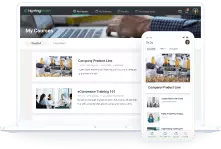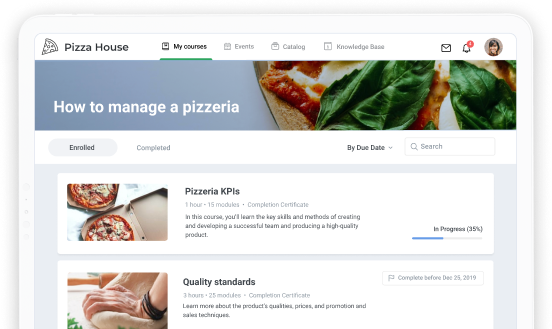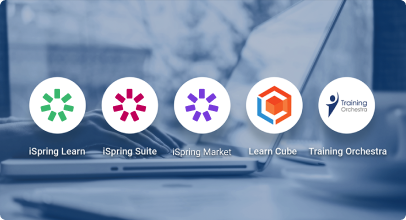The Best 5 Employee Training Management and Tracking Software

Training has a great impact on employee motivation, retention, and overall performance. But if you just deliver training and don’t monitor employees’ results, you’re only doing half the work.
By tracking employee training, you can ensure that your employees learn what they are supposed to learn, your training program is effective, and, lastly, all this is a worthwhile investment for your company.
In this article, we’ll consider five employee management and tracking software that will help you monitor your employees’ progress without the hassle of paper reports and daunting spreadsheets. But before we review these solutions, let’s see what is special about these tools and how they can benefit businesses.
What Is Training Management and Tracking Software?
Employee training management software is better known as a learning management system or LMS. It is used by companies to provide online learning to their staff members and ensures rapid deployment, high quality of training delivery, data safety, and ease of use. Various platforms have their own strong and weak points, but they generally all function the same way.
Employee training software allows you to create or at least upload eLearning courses, assign training content to individuals or groups of employees, carry out certification, keep track of learners’ performance, and evaluate results. It’s like your online university in which the most tedious tasks, such as grading, processing statistics, and managing employee training records, are automated.
So, if you need to upskill your staff and manage training compliance effectively, consider trying out some of the employee training software solutions covered below. It will lighten your workload and save your time, allowing your employees to perform better.
Best Training Management and Tracking Software for SMB — At a Glance
All five LMSs presented in this review are cloud-based solutions. “Cloud-based” means that a system works on the Web and doesn’t require a setup procedure. Usually, cloud solutions are preferred by those who want to begin working right away and avoid lengthy implementation.
Also, all the platforms are very intuitive, mobile-friendly, and support various types of content. In our review, we will focus on their standout features and define use cases for each platform.
1. iSpring Learn
Rating: 4,7 / 5 – 87 reviews (Capterra)
Vendor’s promise: “Fast LMS for your mission-critical project.”

The iSpring Learn dashboard
iSpring Learn is an easy-to-use cloud-based LMS for teaching and assessing employees online.
What differentiates iSpring Learn from its competitors is iSpring Suite, a powerful authoring toolkit integrated with the LMS. Unlike built-in course builders that some LMSs have, iSpring Suite allows capabilities beyond embedding a video from YouTube and creating simplistic text courses. With its help, a course developer or even a training manager with no ID experience can build high-end interactive eLearning with advanced assessments, video lectures, and communication simulations.

Training content that is easily created with iSpring Suite
The output can be uploaded to the system directly from the editor in two clicks. And since the platform and the authoring toolkit were initially developed to naturally complement one another, you get extended reports on content and users.
Pricing
There are two types of subscriptions for iSpring Learn – Start and Business. With the Start subscription, you’ll get all of the basic LMS functionally needed for effective employee training. The Business subscription provides all the Start features, plus a unique set of additional capabilities.
Both subscriptions use an active-user pricing model. This means that you can register any number of users, but a user is considered active only if they logged in at least once during a given month. iSpring Learn’s plans range from $2.87 per active user per month for 100 users to $2.55 per user per month for 1,000 users.
What Do the Customers Say?

Real reviews from iSpring Learn users. Source: Capterra
Summary
iSpring Learn is an appropriate solution when you need to implement employee training easily and quickly — within a day, for example.
Thanks to its simplicity and charging for active users only, the LMS fits for both lifelong learning and sporadic ad-hoc use. Together with the powerful authoring tool (plus, a mobile app for learners and excellent tech support), iSpring Learn is a full-fledged environment to level up your onboarding, compliance and other training initiatives and educate your employees, partners, and customers effectively.
iSpring Learn LMS
Automate corporate training and improve employee performance.
2. Docebo
Rating: 4,2 / 5 — 108 reviews (Capterra)
Vendor’s promise: “Align the training needs of your organization with those of your learners with an LMS that uses learning-specific artificial intelligence algorithms to produce deeper and more effective learning experiences.”

Image credits: Docebo
Docebo is a flexible and scalable platform that offers a complete enterprise learning solution.
Two of Docebo’s features that strike the eye right after signing up are its white labeling and branding options. In most of the LMSs, extensive page customization is something of a privilege. In Docebo, you can customize literally everything: from a sign-in page background to the look of a course catalog; you can even set up your logo and colors for their mobile app.
In addition to visual customization, the platform also provides extensive localization. Available in 40 languages, it benefits extended international enterprises and industries that need to train employees all around the world. One may notice that some of the localizations feel like they’ve been translated by a machine. However, once you have this basic translation, you can download your own language template and improve it.
Another great thing about Docebo is Coach and Share, a solution for informal social learning that encourages creating user-generated content. Employees can share their insights and best-practices by contributing presentations, guides, or video instructions to channels. Learners can also ask for feedback or help with the materials. They can get answers from other users or internal subject-matter experts in a way that’s similar to a helpdesk: the experts can see a list of pending questions and respond to them.
Pricing
Docebo’s pricing plans vary depending on your number of learners, features needed, and services provided. According to FindTheLMS, the annual pricing starts at $2,000 and can reach $500,000. The exact numbers you can only learn if you send a price request to the provider.
What Do the Customers Say?
Summary
Thanks to its platform capabilities, Docebo deserves to be on your shortlist when choosing employee training management software for your company. At the same time, technical sophistication also brings complexity. While some of Docebo’s customers are satisfied with its rich feature set, others are disappointed with the amount of support provided by the vendor. So, if you’re considering Docebo, you’ll likely need to allow extra time for working through its learning curve.
3. LearnUpon
Rating: 4,8 /5 — 64 reviews (Capterra)
Vendor’s promise: “Learning as it should be. Train your employees, partners, and customers with LearnUpon’s LMS. Manage, track, and achieve your learning goals — all through a single, powerful solution.”

Image credits: LearnUpon
LearnUpon is a versatile platform that can be used for both internal employee training and external partner training.
While the company provides its customers with top-notch support at every level, the functionality of this training management software correlates with the pricing plan. At the same time, each customer has a personal relationship manager who is involved in any possible issues.
While the company provides its customers with top-notch support at every level, the functionality of the platform correlates with the pricing plan. So, if you start with the Basic plan — it costs as much as €599 (~$663) per month — you won’t have such features as gamification, assignments, and facilities for blended learning, which are available on the upper plans.
Another feature that is smoothly implemented in LearnUpon (but depends on the plan you chose) is easy switching between learning portals. This allows you to create and customize individual learning environments for different types of learners — employees or partners — or organizations.
Pricing
A LearnUpon basic plan will set you back €599 (~$663) monthly for up to 50 active users. Upgrading the plan increases the number of users and available features. So, at €999 (~$1106) per month, you can create two learning portals, incorporate blended learning, use gamification, assignments, and e-commerce features, and have up to 250 users. For €1,699 (~$1873), you can also rely on some additional integrations, SSO, and a larger number of users allowed.
What Do the Customers Say?

Real reviews from LearnUpon users. Source: Capterra
Summary
This learning management system has extremely warm reviews from their customers, and almost everyone mentions the platform’s user-friendly interface, sleek design, and superb customer support.
For some smaller companies, their plans might seem significant, and they probably won’t be able to afford it; otherwise, it’s a great solution for employee, partner, and extended enterprise training — thought out, simple-to-start, and easy-to-use for both training managers and users.
4. Litmos
Rating: 4,2 /5 — 238 reviews (Capterra)
Vendor’s promise: “Training in the NOW. #1 Training Platform for Customer-Oriented Enterprises.”

Image credits: SAP Litmos
SAP Litmos is a cloud-based LMS designed to launch, deliver, and track on-demand employee training quickly for thousands of learners. It’s also a user-friendly system for both the admin and the learner, as its design looks nice, and the interface is self-explanatory.
SAP Litmos created Litmos Heroes, a huge marketplace where you can access over 15,000 off-the-shelf learning resources for any industry. The courses are made in a bite-sized video format (5 to 20 minutes long), which is good for learners’ engagement.
Together with a built-in editor that allows you to create simple eLearning content, it makes a good choice for companies that don’t currently have an instructional designer or would like to save both time and money by producing their own employee training content.
Pricing
SAP Litmos offers two pricing plans. One is the actual LMS billed per user per month, and another includes access to the Litmos Heroes course collection.
For those only seeking an LMS, it’ll be $6 or $4 per user if the company falls into 150-500 or 500-1000 tier correspondingly. If you have fewer than 150 users per month, you can only choose the plan with their course library ($15 per user). And, of course, there are custom plans for those who have over 1,000 learners per month.
What Do the Customers Say?

Real reviews from SAP Litmos users. Source: Capterra
Summary
While some clients seem to be upset with the support provided by the SAP Litmos team, other trainers and admins find the platform intuitive and super easy-to-use, so the actual support may not be needed. Indeed, for this review, we did a short trial of the LMS and figured out how to use it in no time.
Of course, some issues can only be seen at a longer distance, so it’s a rule of thumb when choosing an LMS to try to reach its existing customers and learn about their experience firsthand.
5. TalentLMS
Rating: 4,6/5 – 317 reviews (Capterra)
Vendor’s promise: “The fastest path to better training. A super-easy, cloud LMS software to train your employees, partners, and customers.”

Image credits: TalentLMS
Although all the learning management systems in this list are quite user-friendly (save for Docebo, perhaps), TalentLMS seems to take it to the next level. After you sign up for a trial, you’re met by a discrete yet well thought out product tour that walks you through the first steps and makes you feel at home with the main features the platform offers.
The LMS is also distinguished by flexible gamification settings. TalentLMS’s gamification engine allows you to add gaming and competition elements in the proper places, and configure it to meet particular use cases. For example, you can create some hidden bonus content that is only available to learners who have reached a certain level.
The TalentLMS developers have also worked on integrations with many useful tools. There are over 200 integrations with third-party services: Zapier, Shopify, Salesforce, WordPress, Slack, Zendesk, GoToMeeting, Trello, PayPal, Stripe, and more. It’s pretty cool for those who have a rich environment of different services, as you won’t have to pay extra to link everything together.
Pricing
To start with, TalentLMS allows you to choose whether you’d like to be charged for the total number of registered users or for active users per month. Then you can also choose to be billed monthly or yearly (yearly is cheaper).
The plans range from $69/month for 40 registered learners to $459/month for 1,000. For comparison, 40 active users will be charged $149 a month, while for a 500, there’s almost no difference — it’s $519/month.
Also, if you want to start really small, you can give their free plan a try. This allows you to have only 5 registered users and 10 courses on the learning portal, which is little even for the smallest businesses, but it’s enough to get your feet wet.
What Do the Customers Say?

Real reviews from TalentLMS users. Source: Capterra
Summary
TalentLMS doesn’t tie its functionality to how much you pay, as all plans include their core features. It means that even the smallest business won’t feel like Cinderella on the breadline in comparison to the larger enterprise clients.
Together with the ease of use that lets you quickly start without any assistance from customer success managers or prior training, TalentLMS makes a good choice among employee training and tracking software.
Learn More About Training Management and Tracking Software
Here is some more information about the LMSs that you might find useful for training delivery and assessment.
Who Needs a Learning Management System?
As its name implies, a learning management system can benefit everybody who deals with educating people. To be more precise, it can help:
- Learning and development departments. Many companies around the world have L&D departments and training managers who use LMSs to deliver training programs to employees, schedule training sessions, and assess the staff’s knowledge and skills.
- Human resources departments. Some businesses don’t have dedicated L&D departments, but have HR professionals who curate training content.
- Training businesses. Such companies leverage LMSs to manage courses that can be sold as a service to corporations that don’t have their own training management systems.
How to Track Employee Training Progress with an LMS
A good learning management system features powerful reporting functionality and works as a training tracker as well. It can gather employee training records and present them in the form of various reports. This allows you to track employee training and monitor how your entire team or individual team members are performing at any time without having to ask them directly.
When using such employee training software, you can track a variety of central metrics. For example, you can see how:
- Learners read through materials, interact with the content, and how they’re progressing
- A specific employee takes courses and quizzes, their statuses, scores, number of attempts, time spent, and more
- Your team members attend offline employee training events and virtual training sessions
For users’ convenience, modern training tracking software solutions typically have a visual display that enables them to get an overall picture of what’s going on at a single glance. As in the example below, by generating a relative report, you can get an instant overview of training sessions and their attendance.

Visual reports in iSpring Learn
Many employee training tracking software also have filters that let users navigate the records easier and get the required reports quickly. For example, training managers can easily check out the statuses of courses assigned to a certain learner or find out how a specific department is learning.
FAQ on Training Management and Tracking Software
Let’s take a look at a few more questions that you might have.
How can you measure the effectiveness of employee training?
For a start, you need to equip yourself with one of the approaches to training evaluation (e.g., the Kirkpatrick model, the Learning-Transfer Evaluation Model) and then identify a particular set of required metrics that your training tracking software provides; then monitor them on a regular basis. Learn more about employee training metrics here.
What is the best way to track training?
It’s best to combine the automatic collection of training records in your training tracking software with regular monitoring of learner progress by managers of all levels.
Conclusion
Here’s the bottom line for choosing employee training and tracking software. As you’ve probably noticed, in spite of many things they have in common, like being easy-to-use cloud services, each of them represents a unique bundle of features, services, and pricing plans.
Looking for employee training tracking software that is easy to use but has powerful LMS functionality and great content authoring capabilities? Book a free demo of the iSpring Learn LMS and find out how it will help address your training needs.











